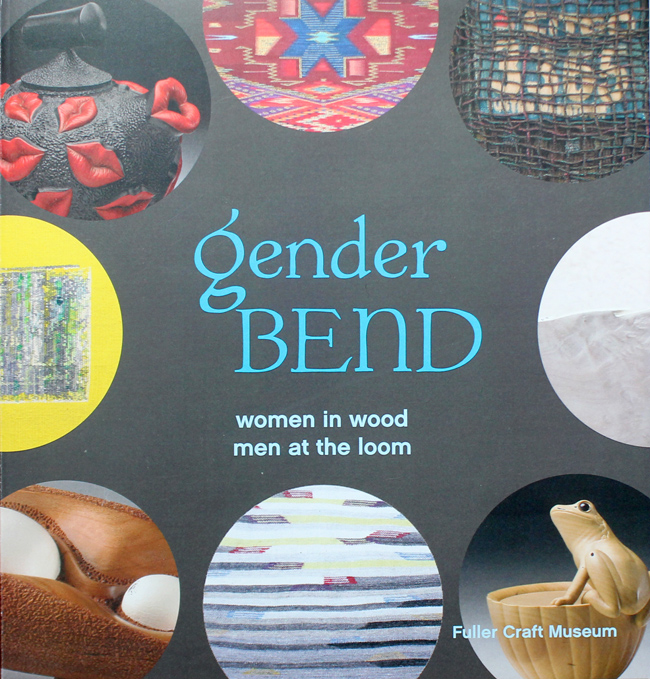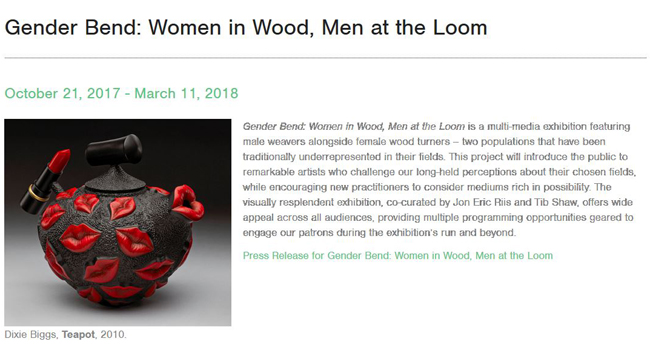
| Fuller Craft Museum catalogue |
Gender Bend: |
The Fuller Craft Museum — one of the few remaining art museums in the U.S. focusing on the craft media arts — is located in a beautiful parkland setting in Brockton, MA. The esteemed guest curators of the Fuller's exhibition of female woodturners and male tapestry weavers were wood art writer Tib Shaw of the American Association of Woodturners and fiber artist Jon Eric Riis. The results were a striking exhibition of art that challenged the inaccurate stereotypes permitted in modern art research. In the Forward of the exhibition's beautiful catalogue, Association Curator Michael McMillan wrote that in the 21st Century "just as the term 'craft' often battles with accusations of being more 'everyman' than fine art, there continues to be cultural presuppositions about the masculine and feminine nature of applied handwork, and how they correlate to artistic and practical value." As part of the Fuller's mission "to be a platform for the spectrum of conversations in craft," the museum's exhibition made an admirable attempt here. Unfortunately, it appears that this particular worthy conversation failed to echo beyond the museum's walls. |

Fuller Craft Museum website announcement |
In its published announcements and press releases (e.g.; above notice) the Fuller prominently asserts in the very first sentence that this is an exhibition featuring "two populations that have been traditionally underrepresented in their fields." What an uncomfortable truth ! Professional institutional research purporting to be scholarly should never, ever traditionally underrepresent populations without clearly disclosing such omissions in the published research itself. In the field of contemporary fiber art, the greater problem of traditional underrepresentation — also known as traditional prejudging of populations or as prejudice discriminating against populations — concerns the entire field of fiber art itself. Not just its male artists, but the entire field of contemporary fiber art's artists, male or female, is largely omitted from institutional research on contemporary craft media arts. That has created a highly inaccurate and misleading impression that the field of contemporary fiber art is one of the smallest and least significant of the craft media arts, regardless of the field's gender identification. For example, a third of a century ago in 1986, the American Craft Museum published Craft Today: Poetry of the Physical edited by Paul Smith. That seminal catalogue unambiguously pointed out that: |
"[T]he recent history of craft as it is reflected in print is subject to some unexpected distortions. For example, although ceramics is not the largest field of activity — that honor almost certainly belongs to fiber — the recent history of American craft ceramics is more fully recorded than work in any other medium." |
Art research practice on contemporary fiber art fails to include the necessary elements required in accurate reliable scholarly research in all other fields of the liberal arts and sciences, e.g., transparency, due diligence, collegial challenge, etc. It is amply documented that the existing institutional art research lacks transparency. It rarely requires clear accounting of what is traditionally omitted from its projects. Nowhere does it clarify its required due diligence. No discussion of the structure of the research is encouraged, no less permitted. In a nutshell, institutional research which traditionally underrepresents populations without being held accountable for those traditional omissions of certain populations is simply not scholarly quality research. It is merely popular expository writing. Ironically, while striving to champion traditionally underrepresented populations of craft media artists, the Fuller's exhibition was almost entirely ignored. Only one very brief newspaper review of the Fuller's exhibition seems to be publicly available. In that sole available article, the reviewer referred to one of the weavers not as "he," but as "she." On the one hand, the principal point of the exhibition itself — that the weavers in it were not females — went entirely over the head of the exhibition's reviewer. On the other hand, ironically, the reviewer has indeed dramatically demonstrated the unreliability of the dominating inaccurate art research on this field that generates inaccurate stereotypes about contemporary fiber art. And the last, but not least, of the anomalies calling out for sunlight and remedy, is that although the Fuller's important exhibition focused on populations of craft artists that are traditionally underrepresented in institutional art research, the museum has no photos of the installed exhibition to share and be used to further the important "conversation" so clearly needed here. |